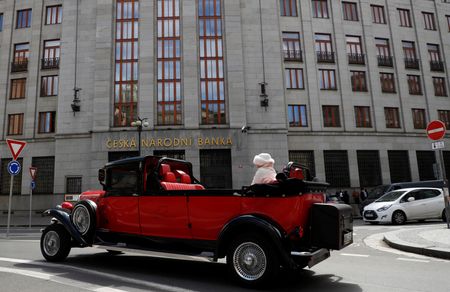(Adds dropped word ‘imputed’ in ‘imputed rents’, paragraph 12)
By Jason Hovet
PRAGUE (Reuters) -The scope for another Czech interest rate cut is limited and monetary policy is likely to be stable for some time, as services inflation stays high and the economy improves, central bank policymaker Jakub Seidler said in an interview.
Seidler said data has shown economic activity performing better than expected. At the same time, some inflationary risks are materialising, while uncertainties around global trade wars have eased, he told Reuters.
The Czech National Bank, which meets on August 7 on policy, has deployed a stop-go strategy since December, cutting rates twice while holding steady three times, including at the last meeting in June when it left the main rate at 3.50%. It has cut by a total 350 basis points since 2023.
Seidler, who joined the bank’s seven-member board last December, said he would support keeping rates steady at the next meeting.
“We are still very close to the so-called neutral rate, so I think ‘on hold’ right now is something that for me is quite a natural choice,” Seidler said.
“Generally, given all the risks around and better economic activity and weaker uncertainty related to trade wars, the scope for a further cut is very limited unless we see some unexpected event.”
HEADLINE INFLATION
He said the current environment could mean there would be no cut in rates before the end of the year.
“Based on all current information, I would say the (main) rate would stay stable for some time … Unless we see some unexpected developments, it is even possible that we are done” in the rate-cutting cycle, he said, adding the discussion could again be opened if some inflationary risks calm.
In June, headline inflation hit 2.9% year-on-year, at the upper end of the 1 percentage-point tolerance band around the bank’s 2% target. Prices of services rose 5.0%, a level Seidler called too high.
“I think the disinflationary process in services is slower than I would expect or is desirable, which in my view brings some case for more careful monetary easing,” he said.
Higher real-estate prices transmitting into imputed rents, along with solid household demand, a shift to services in the economy, and wage growth in the sector are keeping service price growth elevated, he said.
Seidler said some inflationary risks in imputed rents, food prices and wage growth were materialising, and he expected a slightly higher inflation forecast for 2025 in the bank’s new outlook due next week.
An upward revision to the bank’s 2025 gross domestic product forecast of 2.0% growth was also likely, he said, speaking before preliminary data on Wednesday showed the GDP increased by 2.4% year-on-year in the second quarter, the same pace as in the first quarter. On a quarter-on-quarter basis, growth slowed.
He said a question was still over the extent of pre-stocking or frontloading in industry due to uncertainty over global trade wars, before the European Union and United States reached an agreement in the past week.
Overall, he said, the “figures provide reasons for cautious optimism.”
(Reporting by Jason Hovet; Editing by David Holmes and Kevin Liffey)











